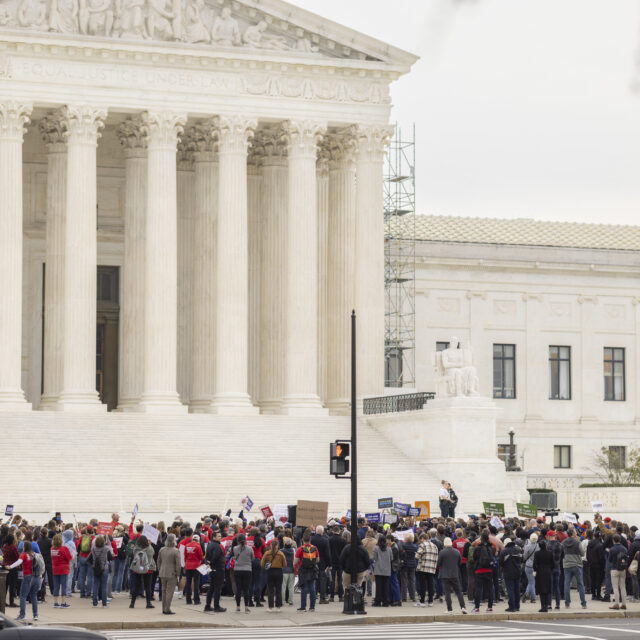
The Supreme Court Struck Down the Federal Ban on Bump Stocks in Garland v. Cargill. Here’s What You Need To Know.
On June 14, 2024, the Supreme Court struck down the federal ban on bump stocks in a 6–3 decision in the Garland v. Cargill case.
As a result of this ruling, bump stocks are now legal to buy and possess in many states across the country. Many states that do not have their own laws on the books specifically banning bump stocks will immediately find that bump stocks are legal. Up to 34 states may be affected immediately.
-
How the Justices Voted
- Justice Clarence Thomas delivered the opinion of the court
- Chief Justice John Roberts and Justices Samuel Alito, Neil Gorsuch, Brett Kavanaugh, and Amy Coney Barrett joined Thomas in the majority opinion
- Justice Alito filed a concurring opinion
- Justice Sonia Sotomayor filed a dissenting opinion
- Justices Elena Kagan and Ketanji Brown Jackson joined Justice Sotomayor in her dissent
Catch me up: What was the question in this case?
The key question in Garland v. Cargill was this: Can a bump stock be classified as a machine gun under the National Firearms Act of 1934?
-
Learn more about the case background
The National Firearms Act (NFA) is a federal statute tightly regulating the sale of machine guns. It defines a machine gun as “any weapon which shoots, is designed to shoot, or can be readily restored to shoot, automatically more than one shot, without manual reloading, by a single function of the trigger.”
An NFA amendment in 1968 amended the machine gun definition to include parts that create machine guns, and further amendment in 1986 prohibited civilians from owning newly manufactured machine guns. Machine guns have been tightly regulated under federal law for 90 years. The gun industry invented bump stocks to skirt federal law and make assault weapons even deadlier.
In 2017, Americans witnessed just how damaging guns equipped with bump stocks can be. A gunman, wielding 14 rifles outfitted with bump stocks, killed 60 people and wounded at least 411 more at the Las Vegas Route 91 Harvest Festival—the deadliest mass shooting in modern American history.
The Bureau of Alcohol, Tobacco, Firearms and Explosives (ATF) went through a rulemaking process to clarify its position on whether bump stocks were considered machine guns.
ATF issued its final rule in 2018 making clear that bump stocks qualify as machine guns under the NFA. ATF observed that when a shooter outfits an assault weapon or other semi-automatic weapon with a bump stock, it becomes a functional machine gun—and can fire hundreds of rounds a minute with a single pull of the trigger.
Remind me: What are bump stocks?
Bump stocks are so-called “conversion devices” for semi-automatic AR- and AK-style rifles—effectively allowing these rifles to fire like machine guns—that harness the gun’s recoil to increase its rate of fire to up to 800 rounds per minute. Bump stocks were designed to mimic automatic gunfire while evading the laws that ban machine guns.
Rifles are designed to be fired with their back end, or “stock,” resting against a shooter’s shoulder. A bump stock is a replacement shoulder stock for a semi-automatic rifle that allows the gun to slide back and forth with ease. To fire, the shooter holds the bump stock against their shoulder while keeping their trigger finger stationary on the trigger (or, more precisely, on the “trigger ledge”) The shooter then grips the front half of the rifle as they normally would and pushes forward until their trigger finger engages the trigger.
After firing one shot, the rifle reciprocates in the bump stock. As it does so, it recoils and “bumps” into the shooter’s stationary trigger finger to fire again and again. The shooter doesn’t have to move their finger continuously to keep firing, but rather can simply hold their finger steadily in place. This is known as “bump firing.”

Why did this case go to the Supreme Court?
In April 2018, the plaintiff in the case, Michael Cargill, bought two bump stocks. He did so legally, as ATF had not yet finalized its rule clarifying that guns with bump stocks are machine guns. The production, sale, and possession of bump stocks were not yet prohibited.
After ATF officially finalized this rule, Cargill “‘surrendered [his bump stocks] to ATF on March 25, 2019’”—as he was obligated to do per ATF’s rule. On that same day, Cargill challenged ATF’s rule in the Western District of Texas.
Both the district court and three judges on the Fifth Circuit Court of Appeals upheld ATF’s rule, holding that “bump stocks qualify as machine guns.” However, after the case was reheard by the Fifth Circuit en banc (i.e., by a full panel of appeals court judges), the decision was reversed. In their reversal, the Fifth Circuit stated that ATF did not have the authority to issue the rule defining guns with bump stocks as machine guns. The ruling effectively legalized bump stocks in Texas, Louisiana, and Mississippi. The ruling also conflicted with the rulings of other federal courts of appeal.
The Supreme Court heard oral argument in this case on February 28, 2024.
What did the Supreme Court decide?
On June 14, 2024, the Supreme Court sided with Cargill, striking down the ATF rule and holding that “ATF exceeded its statutory authority” when it issued the rule classifying a gun with a bump stock as a machine gun.
Reminder: The National Firearms Act defined a machine gun by whether multiple bullets could be fired “automatically” and “by a single function of the trigger.”
The Supreme Court said, in part, that:
- “[A] semiautomatic rifle equipped with a bump stock is not a machinegun because it cannot fire more than one shot ‘by a single function of the trigger,’” and that
- “[E]ven if it could, it would not do so ‘automatically.’”
The Supreme Court held that guns with bump stocks are not machine guns because “firing multiple shots using a semiautomatic rifle with a bump stock requires more than a single function of the trigger.”1Emphasis added.
When a person is firing a gun equipped with a bump stock, they “must maintain forward pressure on the rifle’s front grip” with the hand that is not pulling the trigger. The Cargill ruling found that this “forward pressure” is an additional component of the mechanics necessary to fire a weapon that is not “automatic.”
To reach this decision, the Court compared the mechanics of firing an automatic gun and a semiautomatic rifle equipped with a bump stock. When firing an automatic rifle, “[s]imply pressing and holding the trigger down on a fully automatic rifle is not manual input in addition to a trigger’s function,” the Court stated. “By contrast, pushing forward on the front grip of a semiautomatic rifle equipped with a bump stock is not part of functioning the trigger.”
The dissenting opinion, authored by Justice Sotomayor, sharply criticized the decision: “Today, the Court puts bump stocks back in civilian hands. To do so, it casts aside Congress’s definition of ‘machinegun’ and seizes upon one that is inconsistent with the ordinary meaning of the statutory text and unsupported by context or purpose.”
“When I see a bird that walks like a duck, swims like a duck, and quacks like a duck, I call that bird a duck. A bump-stock-equipped semiautomatic rifle fires ‘automatically more than one shot, without manual reloading, by a single function of the trigger.’ §5845(b). Because I, like Congress, call that a machinegun, I respectfully dissent.”
—Justice Sonia Sotomayor
Justice Sotomayor took issue with the majority’s analysis: “The majority looks to the internal mechanism that initiates fire, rather than the human act of the shooter’s initial pull, to hold that a ‘single function of the trigger’ means a reset of the trigger mechanism,” Sotomayor wrote. “Its interpretation requires six diagrams and an animation to decipher the meaning of the statutory text.”2Emphasis added.
-
More from the Court’s ruling
The majority opinion of the Supreme Court, authored by Justice Clarence Thomas, stated the following:
“A semiautomatic rifle equipped with a bump stock does not fire more than one shot ‘by a single function of the trigger.’ With or without a bump stock, a shooter must release and reset the trigger between every shot. And, any subsequent shot fired after the trigger has been released and reset is the result of a separate and distinct ‘function of the trigger.’ All that a bump stock does is accelerate the rate of fire by causing these distinct ‘function[s]’ of the trigger to occur in rapid succession.”
What happens now?
Up to 34 states may be affected immediately by the Supreme Court’s ruling in Garland v. Cargill. Sixteen states have their own laws clearly and specifically banning possession of bump stocks—but while most other states have broad machine gun and conversion device bans, many that do not specifically address bump stocks will immediately find after Cargill that bump stocks are legal. The Cargill ruling also opens the door to extremists attempting to overturn the existing bump stock bans in the 16 states with state-level laws on the books.
The Supreme Court ruled that guns with bump stocks are not machine guns according to the text of the NFA. However, their ruling does not prohibit state or federal legislators from making laws about bump stocks.
Justice Samuel Alito’s concurring Cargill opinion acknowledges that we can still pass legislation to protect communities from the “lethal effect[s]” of bump stocks.
-
Read Justice Alito’s Opinion
“I join the opinion of the Court because there is simply no other way to read the statutory language. There can be little doubt that the Congress that enacted 26 U. S. C. §5845(b) would not have seen any material difference between a machinegun and a semiautomatic rifle equipped with a bump stock. But the statutory text is clear, and we must follow it.
“The horrible shooting spree in Las Vegas in 2017 did not change the statutory text or its meaning. That event demonstrated that a semiautomatic rifle with a bump stock can have the same lethal effect as a machinegun, and it thus strengthened the case for amending §5845(b). But an event that highlights the need to amend a law does not itself change the law’s meaning.
“There is a simple remedy for the disparate treatment of bump stocks and machineguns. Congress can amend the law—and perhaps would have done so already if ATF had stuck with its earlier interpretation. Now that the situation is clear, Congress can act.”
Bipartisan support
Outlawing the production, sale, and possession of bump stocks isn’t just common sense, it’s bipartisan. The 2017 Las Vegas mass shooting was the deadliest mass shooting by a single perpetrator in our nation’s history. Following the shooting, Republican governors in Massachusetts, Florida, Maryland, and Vermont signed legislation to ban these deadly accessories of war.
Even the NRA supported greater restrictions on bump stocks, but other gun groups filed suit to block ATF’s measure.
Machine guns don’t belong in our communities. Congress can and should fix the Court’s disastrous decision by passing bipartisan legislation to ban bump stocks that has already been introduced in the House and Senate.
Last summer, U.S. Senators Martin Heinrich (D-NM), Susan Collins (R-ME), and Catherine Cortez Masto (D-NV) introduced the Banning Unlawful Machinegun Parts (BUMP) Act. This bipartisan legislation would prohibit the sale of bump stocks and other devices that allow semi-automatic firearms to increase their rate of fire and effectively operate as fully automatic weapons. As of June 20, 2024, the BUMP Act had 27 additional cosponsors.
Representatives Dina Titus (D-NV), Brian Fitzpatrick (R-PA), and Dan Kildee (D-MI) introduced similar bipartisan legislation, the Closing the Bump Stock Loophole Act, in the House. As of June 21, 2024, the Closing the Bump Stock Loophole Act had more than 150 cosponsors.
When we elect leaders who are committed to keeping us safe, we don’t have to just defend the status quo: We can demand better.
The Latest

The Supreme Court Upholds Life-Saving Ghost Gun Rule in Bondi v. VanDerStok. Here’s What You Need to Know.

Voter Guide: What To Know Before Election Day

What You Need To Know About Garland v. VanDerStok Ahead of Oral Argument





